A Roaring 2020
Early on in this remarkable year, a deadly new virus jumped across oceans and changed the landscape of our lives. Donning masks, distancing physically, and washing hands more than ever became commonplace. And trial courts, appellate courts, and the Ohio Supreme Court had to rethink and reorganize to keep the wheels of justice moving – in a year truly like no other.

Courts were filled, as always, with criminal cases and civil disputes, forcing judges and court staff to pivot. And they did, displaying impressive flexibility, creativity, and resilience. They altered long-standing practices and found new ways to maintain the critical operations of the judicial branch.
The Supreme Court’s year began with the January publication of the “Judicial Guide to Public Health” – an eerily prescient guide for courts in handling health emergencies – including a pandemic. The Court partnered with Ohio Department of Health experts to update and expand the piece, first published in 2010. Chief Justice Maureen O’Connor had been a member of the National Center for State Courts Pandemic and Emergency Response Task Force, which published a pandemic handbook for courts in 2016. The chief justice encouraged the development of the updated Ohio guide, which was distributed to all Ohio judges just weeks before COVID-19 hit the United States.
Chief Justice O’Connor Takes Action during Health Crisis
As the coronavirus multiplied and people were asked to stay at home to “flatten the curve” – the upward climb of infection cases – Chief Justice O’Connor put leadership savvy to work, offering guidance and direction for courts statewide.
In mid-March, the chief justice sent a letter to all state judges with guidelines to help the courts weather the coronavirus crisis and keep courts open across the state. She spoke a few days later at a daily news briefing on the health emergency held by the governor for news media and the public.

Chief Justice Maureen O’Connor assisted state courts throughout the pandemic by offering guidance, issuing formal orders, and transferring $6 million for technology needs.
“This is an unprecedented time, a time during which the judiciary of Ohio as well as the bar, and state and local leaders, must come together to guarantee the vital, continued operation of the state’s judicial system and the public’s access to its courts,” the chief justice declared.
She asked judges to prioritize their workload, reduce the need for jury pools, and minimize public traffic in courthouses. She urged them to consider lowering bonds, depend on summonses instead of arrests to lessen jail populations, and maximize technology.
The next week Chief Justice O’Connor issued an order allowing the delay of legal deadlines during the global pandemic. The “tolling” order, made retroactive to March 9, provided uniformity, clarity, and legal continuity for courts. It also permitted the Supreme Court, local courts, hearing panels, boards, and commissions hearing cases to waive any requirement for in-person service or that a party appear in person.
Supreme Court Distributes Dollars to Local Courts
Funding was key to the chief justice’s efforts to support courts during the health crisis. Many of Ohio’s 384 courts lacked the necessary technology to reduce in-person interaction. In March, the Supreme Court dipped into its budget to issue $6 million in grants for technology to help local courts.
“It is my hope that by pushing out this funding on an emergency basis we can assist the local courts with a quick implementation of video conferencing for arraignments and other conferencing needs,” Chief Justice O’Connor said.
This emergency funding enhanced the $3.2 million in technology grants awarded in January for 54 local court projects and $725,000 given in civil justice grants to 19 courts and court-related associations to provide legal assistance to low-income, underserved, and disadvantaged Ohioans – all dollars that took on elevated importance during the unparalleled circumstances.
Given the primacy of technology for keeping courts open and operating this year, Chief Justice O’Connor in September announced a task force to study how courts have relied on technology during the coronavirus pandemic. The Improving Court Operations Using Remote Technology (iCourt) Task Force will identify the best practices for courts to retain in the post-pandemic era and identify ways to continue using technology to improve access to justice.
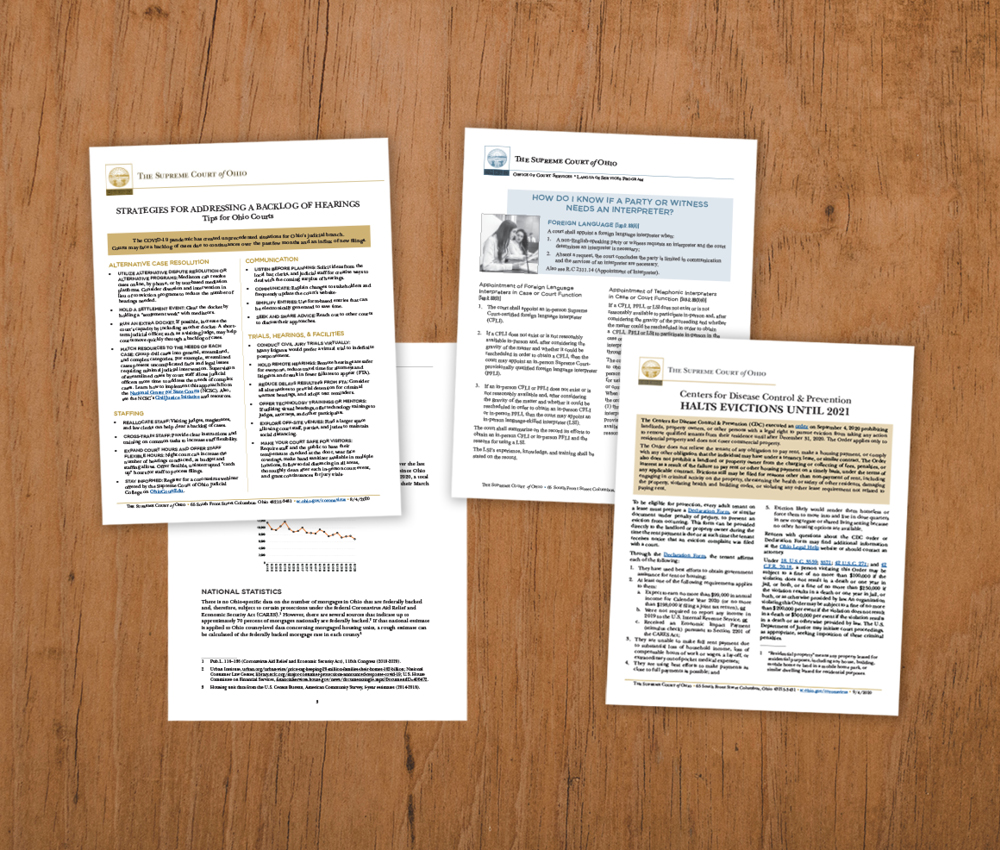
Local courts turned to Court-published tips and direction to adapt and innovate during the health crisis.
The Supreme Court took many other steps to address what had been common day-to-day court procedures that were complicated by the pandemic. For example, many Court-approved forms used by local courts require notarization, so the Court approved temporary versions that eliminated that requirement during the public health emergency.
The Court also issued a report on handling an expected increase in evictions and foreclosures due to increased unemployment and economic uncertainty, and put together a summary of the U.S. Centers for Disease Control and Prevention’s September directive halting evictions. The Court developed handy benchcards for judges to triage civil cases; to handle hearing backlogs; and for working with sign, foreign language, video, and telephonic interpreters in online or remote hearings or proceedings.
Chief Justice O’Connor published direction for mayor’s courts and submitting filings to the Supreme Court. As the COVID-19 pandemic persisted, the chief justice reached out regularly to the state’s judges with updates, including suggestions for continued safety at courts, a response to questions about speedy trial rights, and a holiday message with a roundup of informative resources.
Tutorials for trial and appellate courts about how to stream hearings were posted on the Court’s website. Among the resources: platforms for remote broadcasts and livestreaming, how to set up a streamed hearing, how to record and archive the materials, and tips and ground rules for conducting the online proceedings.
It can’t go without mention that judges and court staff across the state made Herculean efforts to keep the justice system functioning this year in their communities. Court News Ohio covered many of the dozens of examples of their endeavors in On the Bench and Happening Now.
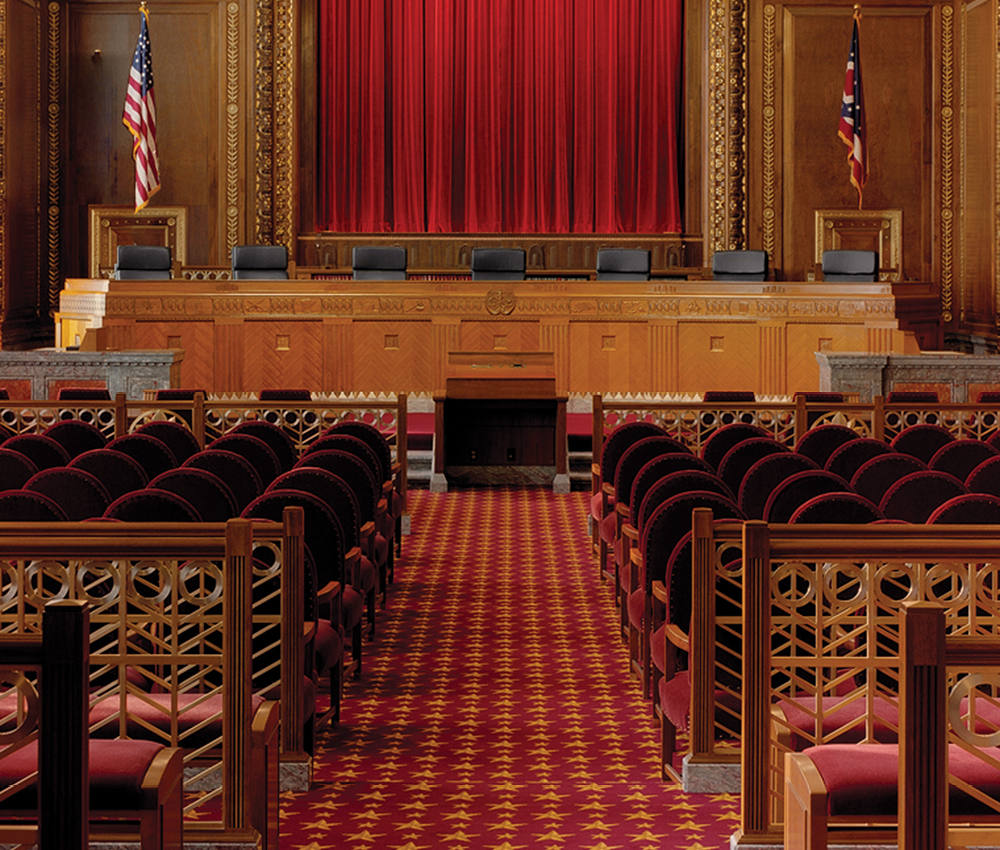
Unable to meet in the Courtroom, the Ohio Supreme Court relied on videoconferences to stay on track with oral arguments.
Meanwhile, the Supreme Court didn’t miss a call to order on its central mission – deciding the state’s toughest cases. For many matters reaching the state’s court of last resort, the parties present oral arguments in person in a public forum before the justices. Restrictions on group gatherings shifted those sessions, normally held in the grand Courtroom at the Thomas J. Moyer Ohio Judicial Center, to online videoconferences.
Long an advocate for open proceedings in the judicial branch, the Court began periodically videotaping and broadcasting oral arguments in 2002 and doing live broadcasts and streaming of every session in 2004. This history empowered the justices to adapt quickly this year to the unexpected, and they missed none of the 28 days scheduled for arguments from January to August 2020. The public could watch the arguments live online, and each case was archived at the Ohio Channel.
Along with the rest of the country, Ohioans saw George Floyd die at the hands of Minneapolis police on Memorial Day. Over the ensuing days, people gathered in scores of U.S. cities to collectively and peacefully protest the killings of Floyd and other people of color as well as the larger racial justice issues in the United States.
The grounds of the Ohio Statehouse were a focal point of peaceful demonstrations for weeks. However, while protesters exercised their constitutional rights, other individuals chose to vandalize the capitol, many downtown buildings, and the Moyer Judicial Center – the Supreme Court’s home.
“As disheartened as I was about what happened to our building, I’m equally as disheartened that people in this state feel disenfranchised, and the treatment that they receive is unfair across all of our institutions,” Chief Justice O’Connor said in the short documentary above about the damage and repair to the building.
The Court’s facilities staff dove in – their swift response and meticulous efforts documented in the video detailing the damage and the careful, weekslong restoration of the judicial center’s limestone façade, fountains, plazas, and windows.
As the repairs were made over the summer, the chief justice penned an Independence Day statement focused on the historic inequities endured by people of color in the United States, broader criminal justice reform, and an appeal to do better.
“In these times of the social unrest that erupted since the killing of George Floyd, it is important to examine the role of the judiciary as we move forward,” she wrote. “The law recognizes the importance of equal justice. But it is up to our court systems, the judges, and the lawyers to ensure that the constitutional guarantees are applied equally.”
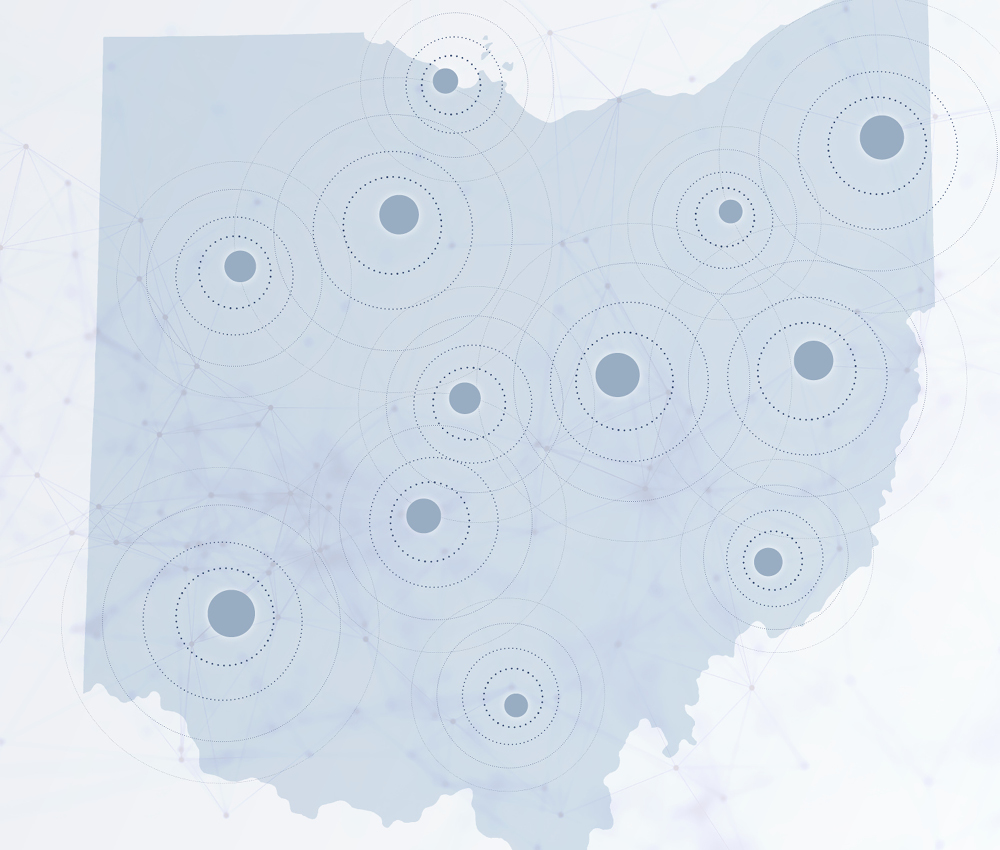
Building a platform for statewide sentencing data begins with a few already-engaged courts driving the early development, then layering in more and more courts.
In her Independence Day article, Chief Justice O’Connor also reiterated her call for overall criminal justice reform, including the creation of a statewide platform for criminal sentencing data. Throughout 2020, the chief justice advocated in varied forums for this potentially game-changing tool.
“The public must be informed so they can have faith in our justice system,” Chief Justice O’Connor said. “They must be able to see equal justice for all and believe what they see. And they must be able to see injustice when it occurs. The way to demonstrate, and then monitor, equal justice is in facts and figures, in metrics and transparency.”
It’s a multipronged initiative, and long overdue, the chief justice said, but she and other leaders in the state’s judiciary are committed to moving Ohio toward greater fairness and justice. An initial, fundamental step – the development of a uniform sentencing entry for courts – was presented to the Ohio Criminal Sentencing Commission in September.
Also part of reforming the criminal justice system is a review of wrongful convictions. The Task Force on Conviction Integrity and Postconviction Review, which held its initial meeting in September, will analyze the postconviction review processes in Ohio and across the country, will review the work of other states’ innocence commissions and conviction integrity units, will make recommendations about scientific advances such as DNA testing, and will share ideas to further public trust and confidence in the postconviction review process.
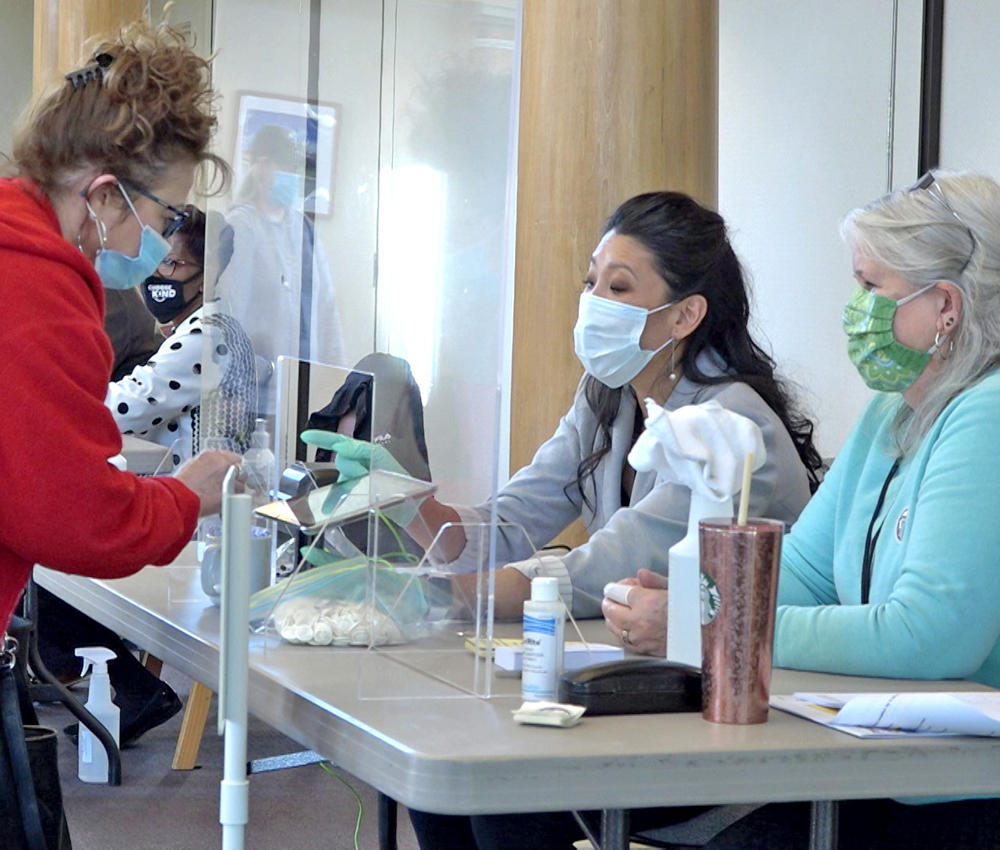
As part of a Supreme Court initiative, more than 1,000 attorneys volunteered as poll workers, helping thousands of voters on Election Day.
The election in November was brimming with contests for seats on many of the state’s courts. In total, 280 candidates appeared on the general election ballot for 216 judicial seats – including two spots on the Ohio Supreme Court, 22 judges for the district appeals courts, 190 openings at common pleas courts, and positions in two county courts – all of whom serve six-year terms.
Election Day posed a pressing challenge because 61% of the poll-worker volunteers in a typical year are 65 or older, falling into a high-risk category for COVID-19. Anticipating a significant decline in poll workers, the Supreme Court issued an administrative order in July offering four hours of continuing legal education credit to any attorney, excluding judges and magistrates, who served as poll workers on Nov. 3. The novel call, coordinated with the Ohio secretary of state, drew national attention in a CBS “This Morning” news segment. The result: 1,026 lawyers stepped up – committing to hours of training and easily 12 or more hours of service on Election Day.
The pandemic also necessitated a switch to unheard-of alternatives for administering the twice-yearly Ohio bar examination and holding the admissions ceremonies that recognize and congratulate new lawyers.
Many who took the standard two-day bar exam in February planned to be sworn in as attorneys in the company of other successful applicants at the Court’s May ceremony in Columbus. They were dealt an unexpected hand as the spread of COVID-19 led to restrictions on such large gatherings. But the celebration found another form, with the Court organizing an online event for 124 applicants who passed. Presided over by Chief Justice O’Connor and livestreamed, the ceremony upheld tradition, too, with thoughtful comments from a justice, a law school dean, and the state bar association president.
The July bar exam traveled its own bumpy path amid the pandemic. This essential step to practicing law in Ohio was first rescheduled to September, with hope for in-person testing, as is customary. The public health crisis dragged on, though, so the Court moved the test to October and converted from overseeing hundreds of applicants taking it in one location to conducting the first-ever online exam in the state. The law school graduates rose impressively to the challenge, with 77.4% passing. Their bar admissions ceremony was held online in mid-December.
Given that the postponements delayed the official launch of many legal careers, the Court adopted a rule in May to enable the recent law school graduates to apply to practice law pending admission to the bar. This interim fix allowed qualifying graduates to practice law under the supervision of Ohio attorneys while waiting to take the bar examination later in the year.
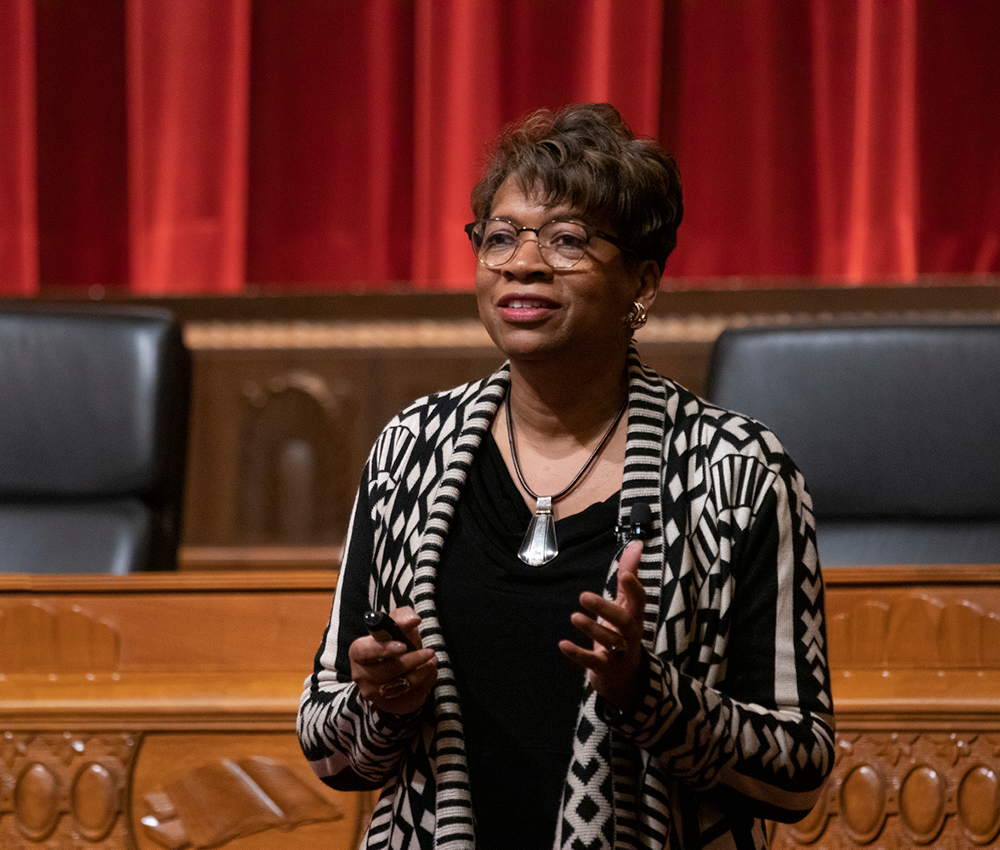
Pre-shutdowns, Justice Melody Stewart entertained high schoolers with song samples to describe how the structure of music informs her work in the law.
Black History Month preceded Ohio’s shutdowns caused by the pandemic, affording high school students the opportunity to attend the Court’s annual February event. Justice Melody Stewart, the first African-American woman elected to the state’s high court, spoke with nearly 200 people – half of them students – at the Moyer Judicial Center. The justice, a pianist with a degree in music theory, shared the harmony she has found between music and the law. Sprinkled through her engaging talk were samples from Beethoven’s Fifth Symphony, Carl Orff’s “O Fortuna,” and even Usher’s “Yeah!”
The year’s other civic education endeavors zeroed in on tools that teachers and parents could turn to as schools adopted online or hybrid setups. The Court offers a superb collection of lesson plans and videos tailored for in-person and virtual learning and aligned with state learning standards. A few additions in 2020 enhanced the expanding resources: “The Human Cannonball’s Flight through the Courts” sets up a mock trial for students based on a real 1970s legal dispute between a human cannonball act performer and an Ohio television station. “Ohio’s Pride” lets students take a close-up look at the Moyer Judicial Center’s colorful murals, exploring the state’s innovations and evolving transportation modes over time.
The health crisis also wreaked havoc on educational opportunities offered by the Court and its affiliate organizations throughout the year for judges, attorneys, and others. The dilemma provoked inventive solutions.
The biennial Dispute Resolution Conference, which draws approximately 500 attendees, was first postponed, then canceled. But keynote speaker Ken Feinberg had arrived in Columbus the night before the scheduled date of the March event. The acclaimed attorney and mediator demonstrated his improvisational skills by presenting his remarks to about 20 people who were already on-site for the conference. The talk was recorded so others could view it later. Event organizers April Nelson, a long-time juvenile court mediator, and Dr. Adonis Bolden, a Delaware County assistant school principal, spearheaded a Dispute Resolution Section “Civility and Solutions” podcast on school attendance and mediation, while a few of the scheduled national speakers delivered their session virtually on the potential of special masters in state courts. Employees in the Court’s Dispute Resolution Section even shifted to training mediation skills online and conducted their regular mediations virtually, with positive results.
The Court’s biggest event of the year – the Specialized Dockets Conference – was transformed from a two-day conference to two months of educational programming. The new Specialized Dockets Fall Education Series featured 16 free webinars focused on topics impacting specialty courts, such as drug courts and human trafficking courts. Aside from saving time and money for travel and lodging, judges and court staff benefited from the chance to participate in more sessions because they were spread out over weeks.
The Ohio Judicial College was forced to adjust its popular on-site programs – a substantial chunk of its catalog of nearly 300 judicial branch courses held annually. The Judicial College’s experienced team repurposed its offerings with vital and easy-to-access education, such as webinars, and promoted its self-study options. As the state’s courts sought guidance on how to best proceed under evolving health and safety standards, the College responded with a multiweek webinar series – “Courts and Coronavirus” – that detailed the impact of the pandemic on the judicial system. The College also gave an extraordinary assist to organizations representing judges, magistrates, clerks, and other court personnel, enabling the groups to still hold their summertime multiday conferences in online venues.
CREDITS:
Design: Ely Margolis
Web: Erika Lemke
Video Stories/Editing: Csaba Sukosd, Anne Yeager
